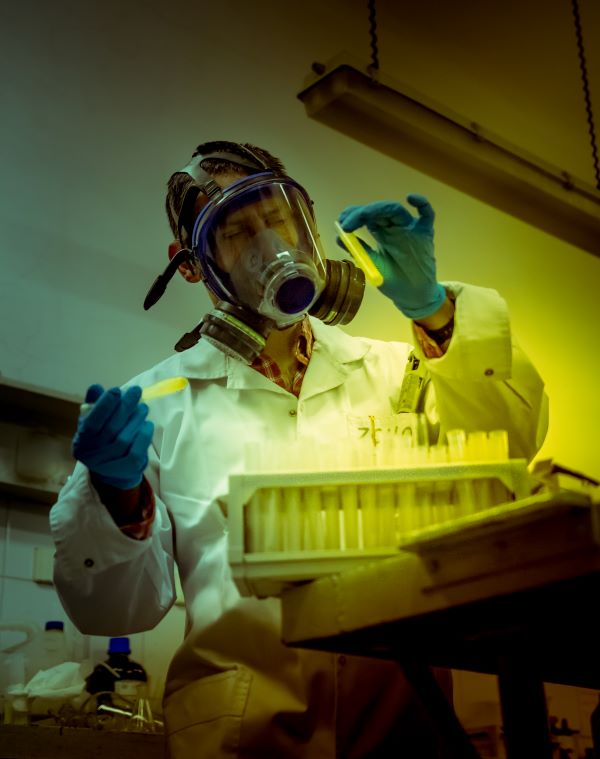Medicine is a rapidly developing field, yet we still face new diseases and are powerless in many cases. Why is it so difficult to find an effective cure? Will we ever discover a way to live a life without unpleasant ailments?
Contact
Prof. Robert Musioł from the Institute of Chemistry at the Faculty of Science and Technology of the University of Silesia – robert.musiol@us.edu.pl
| Written by: Weronika Cygan-Adamczyk |
I’ve been going to doctors for years now and yet I still get sick. Where are the advances in science if we can’t combat old diseases and new ones keep popping up? – say many frustrated patients for whom today’s medicine seems powerless. Meanwhile, laboratories all over the world are constantly making amazing discoveries, which provide the basis for increasingly effective solutions and treatments. So what is keeping us from this beautiful vision of a future without diseases – is it poor science or inefficient healthcare? Or is the world without cancers, genetic defects, and other ailments just a pipe dream after all?
In 2020, the Nobel Prize for Chemistry went to E. Charpentier and J. Doudna for the development of the CRISPR/Cas9 genome editing method, successfully developed for use in the service of medicine today. Two years later, the prize was awarded to C. Bertozzi, M. Meldal, and B. Sharpless for the development of the so-called ‘click’ chemistry, which allows chemical reactions to take place in a rapid and efficient manner, thus providing the basis for the development of even more effective drugs. Last year’s Nobel Prize in Medicine for K. Karikó and D. Weissman for their discoveries allowing for the development of mRNA vaccines that were used against COVID-19 also needs to be mentioned
These are just three Nobel Prizes awarded recently for achievements that improve our chances in the battle against diseases. But before the lucky recipients collect their medals from the Swedish king, they have to spend many years working in laboratories, often suffering failures along the way, and even then, most scientists will never live to enjoy similar recognition and widespread acclaim. But if progress is accelerating and science and technology are advancing faster than ever, why are we still battling cancers, immunological diseases, and new ailments? And why is the pool of the so-called ‘civilisational diseases’ affecting us constantly expanding?
For every drug that gets approved, five others are rejected in the preliminary stages | Photo: Agata Kurczyk and Robert Musioł
1:5
There are several reasons, and none of them will be satisfactory to someone who expects that a great treatment or cure is within arm’s reach.
Prof. Robert Musioł, Director of the Institute of Chemistry of the University of Silesia and Head of the Drug Design and Nanopharmacology Team, explains that one of the main challenges to overcome is to go beyond the next stage of complexity when testing new substances.
‘Together with the Pharmaceutical Biophysics Team, we are conducting research on cell spheroids, which develop in the form of micro-tumours. In this way, we are simulating the behaviour of tumours, so we are dealing with an assemblage of cells. Even at this stage, the activity of the drugs looks completely different from the response of a single cell. There is a problem with diffusion into the inside, and the fact that the cells inside have a different environment from those outside is also an issue. This includes less oxygen and more CO2, which significantly affects their metabolism. All of this may impact the drug’s chances to pass this stage and get into the next phase of testing, this time conducted on a living organism’, explains the expert.
The team of specialists from the University of Silesia is also implementing a project that is now entering the stage of testing on mice and is encountering certain obstacles as well. The chemist stresses that the compound, which has previously been characterised by good solubility and activity (even much better than the other agents previously mentioned in the professional literature), performs much worse in contact with blood. And even though the biochemists’ toolbox has been expanded to include artificial intelligence and computer simulations that have accelerated certain processes, these tools are not a sufficient substitute for tests performed on living organisms. Meanwhile, it all still looks the same in practice, i.e. there are tests carried out on living tissues, animals, and finally humans.
A quick glance at the statistics tells the story: for every drug that gets approved, five others are rejected in the preliminary stages. According to some statistics, as much as 90% of potential drugs fail at some stage of development. This, in turn, contributes to high costs, which consequently increase the price of various treatment options, especially when dealing with rare diseases. For example, one injection to improve the condition of people suffering from amyotrophic lateral sclerosis (ALS) – due to which many children die before the age of 2-3 – can cost more than $2 million. Last year, a similar treatment method was approved in the European Union to treat haemophilia B. It comes with a price tag of up to $3.5 million. Given that we want to create a society with equal access to treatment, this is an aspect that absolutely must be taken into consideration.
Race for a better drug
But what does the search for specific drugs look like ‘behind the scenes’? What do contemporary researchers have at their disposal in the race for better pharmaceuticals?
There has been a lot of talk recently about advances in gene therapy based, among other things, on the previously-mentioned CRISPR/Cas9 solution. In theory, we just have to cut out a fragment of the damaged gene which makes the body produce the wrong protein or block processes necessary for it to function properly. In practice, things are much more complicated – we first need to find a proper carrier to allow for such an intervention in the patient’s body. It is most often a virus, possibly nanoparticles, or even… an electric field. In addition, the vast majority of genetic diseases are caused by damage not to a single gene but to several, which often interact with one another and their environment in ways that are unclear and difficult to explain. So far, gene therapy has been used successfully in the treatment of, among others, certain types of cancer and sickle cell anaemia.
Nanotechnology has also been enjoying considerable interest for a long time, although with certain reservations. ‘Even though several drugs have emerged that have “nano” in their names, it does not really translate into an actual mechanism of action in any of them. Most are drugs that were known much earlier and developed as normal small-molecule chemical compounds with a specific mechanism of action. However, they could have had some undesirable pharmacokinetic parameters, i.e. connected with how the compound behaves in the human body’, explains Prof. Robert Musioł
Nanotechnologia byłaby więc bardziej sposobem na poprawienie pewnych parametrów znanego już farmaceutyku niż nową, rewolucyjną terapią. Zaprojektowane z jej wykorzystaniem leki mogłyby zatem mieć lepszą rozpuszczalność, sprawniej radziłyby sobie z przekraczaniem pewnych barier w ludzkim ciele albo nie traciłyby właściwości po kontakcie z kwasem żołądkowym.
Treatment is most effective in combination with personalised strategy | Photo Ksenia Yakovleva from Unsplash
Personalised treatment
The road to a healthy society will lead not only to the production of new and better substances, even though this is obviously also the case, but to a personalised treatment strategy for specific types of diseases as well. This may involve collecting material from the patient, modifying it, and inserting it into the body to carry out the right treatment. A totally separate problem may be the selection of a set of different molecules with complementary mechanisms of action. This is how treatment for certain cancers and HIV is currently carried out.
The specialist from the University of Silesia provides an example of solutions that are increasingly often used in the treatment of various cancers based on small-molecule drugs: ‘Nowadays, we might also encounter the term “polypharmacology”, because each drug causes more than one reaction in the body and each of them will always have some side effects. However, we aim to correlate them in one direction with the goal to improve the wellbeing of the patient. We know that tumours are way less genetically stable than healthy tissue, therefore, mutations can occur much more quickly and easily. In such a case, administering a single-target drug risks the absurd situation where the drug can accelerate the progression of the disease. Hence, this is why a double hit is supposed to be better than a single hit’, concludes the researcher.
What is the answer to the question presented in the article’s title, then? Robert Musioł leaves no doubt – it certainly won’t be possible to create a universal cure for everything and there will still be diseases that we are unable to avoid. However, this conclusion does not necessarily have to leave us feeling hopeless.
A lot depends on how we define the disease itself. Be it AIDS, COVID-19, or cancer, for which we are already finding better and better treatments. It can also be anything else that involves the harmful effects of broadly defined bodily lesions and causes discomfort, suffering, and a negative perception of the patient.
The fact is that we live longer and our standard of living is steadily rising thanks to advances in knowledge. However, science alone will not solve every problem. Whether access to treatment is equal for all citizens also depends on many other factors, including the politicians we elect. It is also important to try to lead a healthy lifestyle, and thus reduce the risk of contracting certain diseases. If we all base our actions and decisions on sound science, we will be well on our way to a better and healthier society.
The article ‘Searching for the medicines of the future’ was published in the popular science journal of the University of Silesia No Limits no 2(10)/2024.







